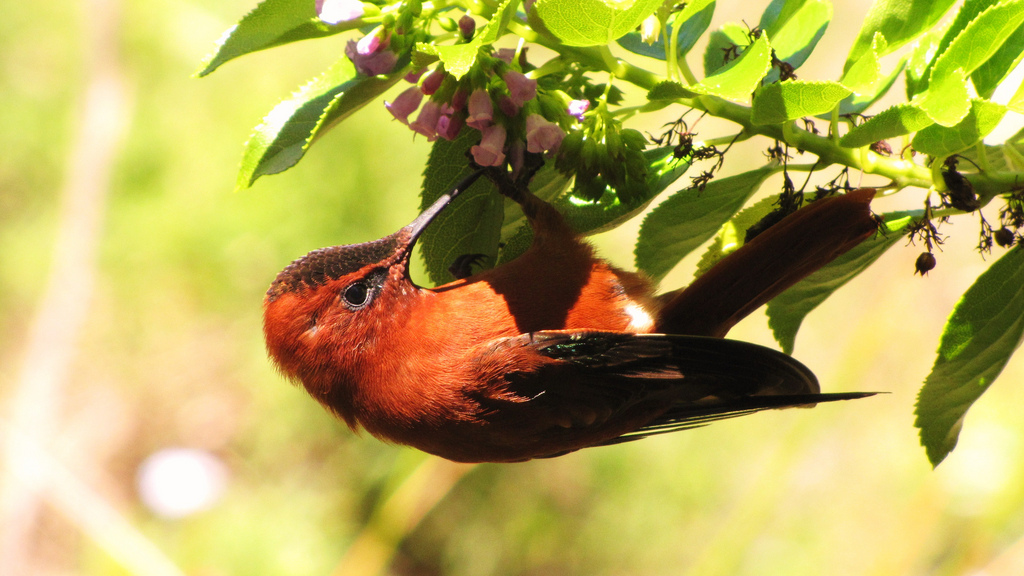Juan Fernández Islands Temperate Forests
The ecoregion’s land area is provided in units of 1,000 hectares. The conservation target is the Global Safety Net (GSN1) area for the given ecoregion. The protection level indicates the percentage of the GSN goal that is currently protected on a scale of 0-10. N/A means data is not available at this time.
Bioregion: Juan Fernández & Desventuradas Islands (NT7)
Realm: Southern America
Ecoregion Size (1000 ha):
15
Ecoregion ID:
560
Conservation Target:
100%
Protection Level:
9
States: Chile
The critically endangered bird Masafuera rayadito, named after the island to which is it endemic—Isla Selkirk (formerly Isla Masafuera)—is a unique and rare resident of the Juan Fernández Islands Temperate Forests ecoregion. It is found primarily on mountaintops. Its small range is correlated heavily with Drimys confertifolia, a tree also endemic to the island.
The Masafuera rayadito can be found, often in pairs, hopping through the understory and lower branches of ferns fronds and shrubs looking for insects. As their native habitats are becoming increasingly threatened by introduced plant and animal species, the populations of Masafuera rayadito has also suffered.

The flagship species of the Juan Fernández Islands Temperate Forests ecoregion is the Juan Fernández firecrown.
The Juan Fernández archipelago, also known as the Robinson Crusoe Islands, is located 667 km off the coast of continental Chile in the southeastern part of the Pacific Ocean and is one of the few regions of the world where there were no permanent human settlement before the 16th century. It comprises three main islands: Isla Robinson Crusoe, the closest to the mainland; Santa Clara, 1 km southwest of Isla R. Crusoe; and Isla Alejandro Selkirk, 181 km further west.
The climate is subtropical and strongly influenced by fluctuations in the general northward flow of the cold subantarctic Humboldt Ocean Current, and the south east trade winds that create a high-winter and low-summer rainfall pattern and a stable temperature environment. Annual mean temperature and rainfall are 15.4°C and 1,081 mm respectively.
Grassy slopes with native and introduced species of grasses and other weeds cover much of the lower altitudes of Isla R. Crusoe and Isla A. Selkirk, as well as nearly all of Santa Clara. Tall lowland forest is dominated by the largest trees in the archipelago, including Drimys confertifolia, Myrceugenia fernandeziana (on Isla R. Crusoe), and Myrceugenia schulzei (on Isla A. Selkirk). All three of these species are endemic to the ecoregion and considered vulnerable.
The Juan Fernández Islands Temperate Forests ecoregion contains a high level of endemic vascular plants and is considered to have significantly high plant species density compared to most other islands. Several such species are considered to hold the keys to understanding the evolutionary history of some major plant groups. In comparison, the terrestrial fauna of the islands lack native mammals, amphibians, or reptiles. However, the islands do boast 5 endemic bird species, including the Juan Fernández firecrown, the only endemic hummingbird known on oceanic islands.
The Juan Fernández Islands were designated a National Park in 1935 and a World Biosphere Reserve by the IUCN in 1977. In addition, Bird Life International identifies them as a critical conservation priority and they also appear in the WWF/IUCN’s global study of Centers of Plant Diversity and Endemism.
There are over 1,000 permanent residents in the Juan Fernandez archipelago, with many more tourists visiting annually (sometimes with unwanted hitchhikers). Feral animals introduced to the islands by human are the greatest threat to local biodiversity, exerting devastating effects on the islands’ habitats, especially on Isla A. Selkirk where there are several thousand goats. Rabbits are the main threat on the other two islands, where several thousand occur in the drier zones.
Logging efforts further exacerbate the effect of introduced animals. Forests cut for timber give rise to a number of colonizing shrubs native to the mainland, introduced to the islands, and consequently an increase in competition for the endemic vegetation. The native flora is characterized by low fire tolerance and poor adaptation to herbivore resistance. It is estimated that more than 50% of the endemics are threatened.
The priority conservation actions for the next decade will be to: 1) manage or eradicate introduced animal and plant populations on the islands; 2) design restoration programs for declining endemic plant species; and 3) identify priority areas for conservation and develop measures to protect the last remnants of native forests.
Citations
1. Bernardello, G. Stuessy, T. 2018. Island group off the coast of central Chile in the Pacific Ocean. https://www.worldwildlife.org/ecoregions/nt0401 Accessed September 28, 2018
2. Saiz, F. and P. Ojeda. 1988. Oryctolagus cuniculus L. en Juan Femández. Problema y control. Anales del Museo de Historia Natural de Valparaíso 19: 91-98.
3. Stuessy, T.F., D.J. Crawford, C. Marticorena, and M. Silva O. 1998. Isolating mechanisms and modes of speciation in endemic angiosperms of the Juan Fernandez Islands. Pages 79-96 in T.F. Stuessy, and M. Ono (editors), Evolution and speciation of island plants. Cambridge University Press, Cambridge, UK.



